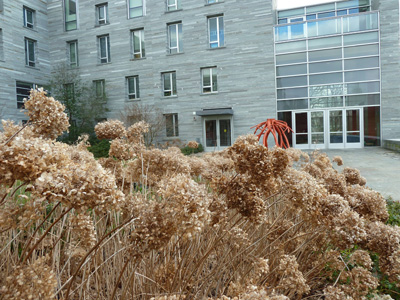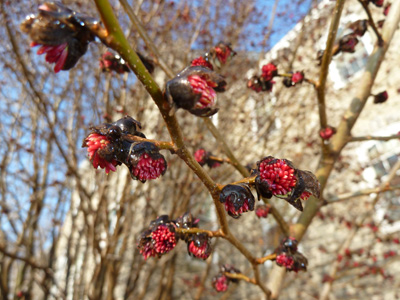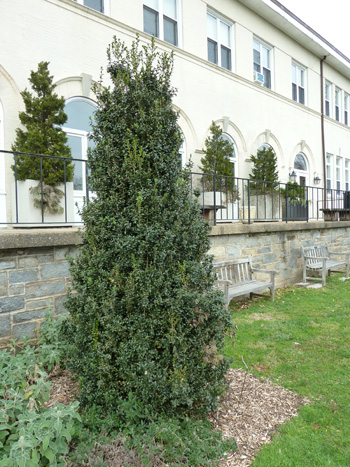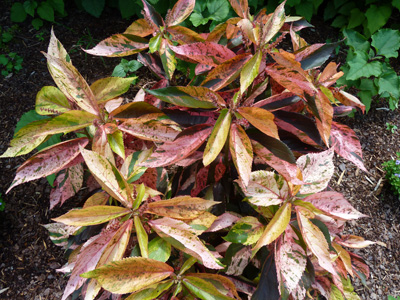Plants of the Week – February 25
 As days grow longer, focus in the garden turns to a range of tasks from tidying hellebore foliage to spreading mulch. Another such task is cutting back select shrubs. From Cornus to Caryopteris and Physocarpus, February is an ideal month to prune. Hydrangea arborescens and selections is another shrub requiring cutback. Degree of cutback is dependent on personal preference with pruning, ranging from near ground level to leaving roughly 12” above ground. Plants flower on new wood so have no fear of cutting back too much. Photo credit: J. Coceano Location: Hydrangea arborescens ‘Annabelle’ planted in mass at Kemp Residence Hall
As days grow longer, focus in the garden turns to a range of tasks from tidying hellebore foliage to spreading mulch. Another such task is cutting back select shrubs. From Cornus to Caryopteris and Physocarpus, February is an ideal month to prune. Hydrangea arborescens and selections is another shrub requiring cutback. Degree of cutback is dependent on personal preference with pruning, ranging from near ground level to leaving roughly 12” above ground. Plants flower on new wood so have no fear of cutting back too much. Photo credit: J. Coceano Location: Hydrangea arborescens ‘Annabelle’ planted in mass at Kemp Residence Hall
 Parrotia persica, a member of Hamamelidaceae, has been in flower for several weeks. Unlike Hamamelis, Parrotia flowers lack petals. Small, maroon-red flowers, borne in copious quantity, are comprised of showy stamens. Cool temperatures of late winter help prolong the display. Photo credit: J. Coceano Location: Front of Trotter Hall
Parrotia persica, a member of Hamamelidaceae, has been in flower for several weeks. Unlike Hamamelis, Parrotia flowers lack petals. Small, maroon-red flowers, borne in copious quantity, are comprised of showy stamens. Cool temperatures of late winter help prolong the display. Photo credit: J. Coceano Location: Front of Trotter Hall
 According to Saunders Brothers Nursery, Buxus sempervirens ‘Dee Runk’ is “an excellent upright cultivar, grown for both for its form and its ability to thrive in a variety of site conditions. Slightly narrower but very similar to ‘Fastigiata’. Excellent choice for narrow hedges.” Prune Buxus in late winter to maintain density and form. Photo credit: J. Coceano Location: Front of Pearson Hall
According to Saunders Brothers Nursery, Buxus sempervirens ‘Dee Runk’ is “an excellent upright cultivar, grown for both for its form and its ability to thrive in a variety of site conditions. Slightly narrower but very similar to ‘Fastigiata’. Excellent choice for narrow hedges.” Prune Buxus in late winter to maintain density and form. Photo credit: J. Coceano Location: Front of Pearson Hall
Many are familiar with the chenille plant, Acalypha hispida, a popular houseplant grown for the pendant, catkin-like red flowers. Other species and cultivars bear bold foliage streaked and splashed with fiery shades of red, orange, and yellow complemented with tones of coral, salmon, and chartreuse. Acalypha wilkesiana ‘Kilauae’ is but one example that thrives in the heat and humidity of summer. Plant in ground or as a container component. Look for several Acalypha cultivars at the upcoming Unusual Tropicals and Annuals Sale. Photo credit: J. Coceano Location: Seasonal display






Jones sabo end jewelry sabo
Posted at 04:18h, 15 AprilI will immediately take hold of your rss as I can’t in finding your e-mail subscription link or newsletter service. Do you’ve any? Please let me recognise so that I could subscribe. Thanks.